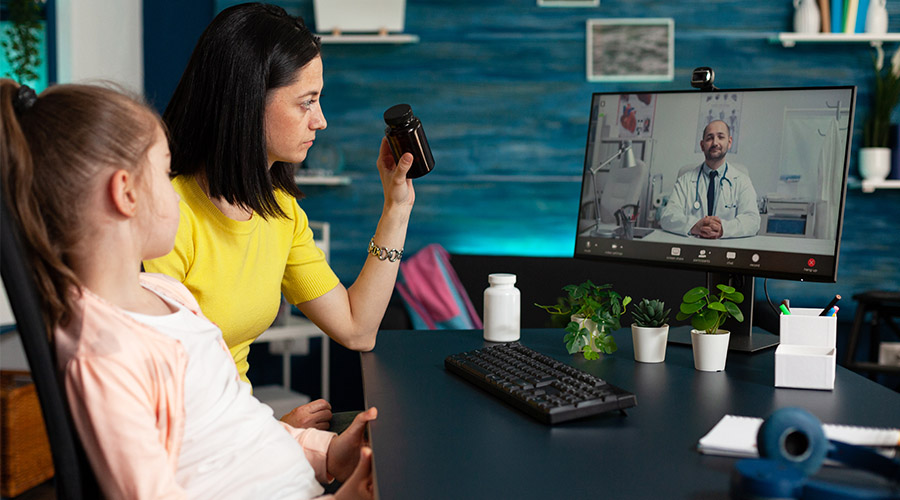
The time when a patient had to be monitored from the hospital until they were fully recovered and monitored is long past. A doctor can monitor a patient from the comfort of their home thanks to technologies like RPM and telehealth. You could not be more mistaken if you believe that telehealth and remote patient monitoring are all the same.
Telehealth is a broad umbrella term that encloses any care that a doctor or clinician provides without an in-person office visit.
RPM, or remote patient monitoring, is one particular telehealth method of healthcare delivery that uses the most recent developments in information technology to collect patient data outside of conventional healthcare settings. Staff members at the clinic keep an eye on this data, which is then used for patient care, education, and communication.
Keep reading this article to learn more about telehealth and remote patient monitoring.
How are Telehealth and RPM different
- RPM and telehealth are not synonymous because they have different meanings. Telehealth is a broad term that refers to the entire industry, methodology, and technologies that enable the type of healthcare anticipated from remote patient monitoring services. In contrast, remote patient monitoring services use specific technology to facilitate interaction between clinicians and patients at home.
- RPM is a type of telehealth delivery system, and the term telehealth may, in turn, refer to remote patient monitoring but is used to refer to many other things.
- In conclusion, telehealth and Remote patient monitoring services are often used interchangeably, but they are not quite the same.
Benefits of Telehealth
It has been two years since the Covid-19 pandemic, and it has been challenging for the healthcare sector. In addition to the patients being quarantined inside their homes to prevent the pandemic from spreading further, there was a staffing shortage. Many people were observing lockdown procedures at the time, and telehealth came to the rescue by assisting in monitoring patients hundreds of kilometers away from medical facilities. Many benefits of telehealth will last beyond the pandemic, including:
1. Accessibility to All: It is a well-known fact that people in rural areas have a higher risk of dying young from heart disease, cancer, accidents, strokes, and respiratory illnesses.
Rural residents exhibit more unhealthy behavior and have less access to healthcare than urban residents. Telehealth can increase access to primary and specialty care for those living in remote areas.
2. Removes Language Barrier: It does not matter which language a patient knows; an interpreter can join a telehealth visit if English isn’t a patient’s first language. The language barrier between the patient and the on-site doctor is reduced thanks to telehealth because the patient can now ask questions and understand what the doctor is trying to say through an interpreter.
3. Convenience: Many avoid getting regular checkups due to their busy work life and busy schedule. A telehealth visit is preferred to save time driving, parking, waiting in doctor’s offices, etc.
4. Get online mental health counseling: Let’s face it, mental illness carries a stigma in many societies, and as a result, some patients avoid talking to others out of fear of being judged. People struggling with their mental health and the stigma they perceive to be attached to such problems may now feel more at ease and secure when receiving care at home.
How to Use RPM with Telehealth
RPM works well with telehealth when patients must be monitored for particular medical conditions. Additionally, it can provide health care to patients who cannot travel.
The reason why RPM is the talk of the time is its ability to track many symptoms and conditions, such as:
- High Blood pressure
- Diabetes
- Heart conditions
- Chronic obstructive pulmonary disease
- Sleep apnea
- Asthma
- Weight gain or loss
- Devices such as weight scales, pulse oximeters, Blood glucose meters and blood pressure monitors, etc. are the different RPM devices that help track different conditions and symptoms.
- There are also complicated devices that help check and monitor conditions, such as Heart monitors, apnea monitors, Breathing apparatus, fetal monitors and specialized monitors for Parkinson’s disease and dementia.
The Future of Telehealth and RPM
Telehealth, which allows for remote patient monitoring, is here to stay and will continue to develop. Telehealth has increased 38 times since the Covid-19 Pandemic began, and consumers are becoming accustomed to it, with 40% saying they intend to use telehealth in the future, as opposed to 11% before Covid.
In 2020, 24 million patients were using RPM; by 2024, that number is expected to reach 30 million.
The use of at-home monitoring in between regularly scheduled office visits is expanded by remote therapeutic monitoring (RTM). RTM is used to track treatment compliance and response to various health conditions.
If you do not currently offer RPM to your patients, you should do so right away to avoid losing them to another provider who does. With the right research and partners, you can put into place an RPM program that supports your overall telehealth strategy, allowing you to enhance patient outcomes and satisfaction while also protecting your staff from overworking.
